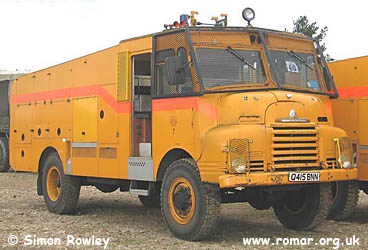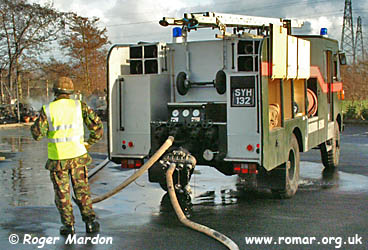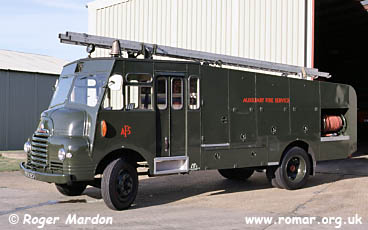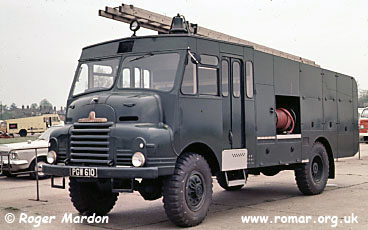

Fire service historian and author
Roger Mardon

www.romar.org.uk
© Copyright Roger Mardon
www.romar.org.uk
All rights reserved

GREEN GODDESS
The Green Goddess emergency pump was designed as an all-
The first emergency pumps were issued in 1953 and within 5 years over 3,000 had been built, along with an assortment of ancillary and support appliances, such as control units, pipe carriers with 1,760ft of 6in plastic or alloy piping, hose layers, foam tenders, transportable water or ‘Bikini’ units, and mobile kitchens.
In 1968, as the threat of war receded, the AFS and the Civil Defence Corps were seen as an unnecessary expense and they were disbanded. Some AFS pumps were sold off, some were mothballed in Home Office depots, and a relative few were bought by local authority brigades.
About 1,000 Green Goddess pumps remained at the beginning of 2005 and in times of
crisis they had sometimes been crewed by military personnel, encouraging the misconception
that they were military fire engines. As with the rest of the fire service, they
were then no longer the responsibility of the Home Office but came under the purview
of the, now defunct, Office of the Deputy Prime Minister -
There were two versions of the emergency pump, with bodywork by ten or eleven companies
many of which were more used to building buses than fire engines. About 1,300 of
the earlier type were built on the Bedford SHZ rear-
Both types had the Sigmund FN4 centrifugal pump able to deliver 900 gallons per minute
(4,090 litres per minute) through four delivery outlets. In addition a full-
The appliance seated a crew of six. As well as the main pump, a Coventry Climax 300gpm
(1,364lpm) light portable pump was carried in a side locker fitted with a sliding
ramp to facilitate withdrawal and replacement. 1,600ft of rubber-
At the time of its construction the Green Goddess was much same, and just as efficient, as its red counterpart.
Since the 1950s the technology of road vehicles and the science of fire-
The Green Goddess fire engine, or self-
Most people will be surprised to learn that it was not until 1938 that the provision
of fire-
The fire service was returned to local authority control on 1st April 1948 and the
AFS, as part of the National Fire Service, disappeared. As part of the Government’s
response to the threat of nuclear war, the Civil Defence and Auxiliary Fire Service
were promptly reconstituted under the Home Office with the idea that both would be
made up of civilian volunteers. The postwar AFS initially relied on wartime fire
engines but a large fleet of purpose-
So to dispel the myth perpetuated by the Media, Green Goddesses were never Army fire engines.
As it happens the Army Fire Service did have some substantially similar appliances but they were generally red!
Essentially the Green Goddess was designed and equipped as a machine for extinguishing
fires on a wartime scale, not as a multi-
Of the last remaining Green Goddesses over 200 were sent overseas by charities to help establish and maintain fire brigades in less fortunate countries but about 60 were scrapped in the eighteen months up to February 2005. The remainder, about 760, went on sale through Witham Specialist Vehicles Ltd of Grantham, Lincolnshire, and on 21 February 2005 the first forty were quickly sold at prices starting from £3,500+VAT. Further sales took place with a view to disposing of the entire stock by the end of March 2008 and it is understood that 60 were sold to Nigeria, some were bought for preservation and some were ultimately scrapped. Twenty remained at the beginning of May and the fate of these vehicles has not been established but it is believed their registration marks were sold as cherished numbers.
For details of what has replaced the Green Goddesses, see The Red Goddess and an Alternative Contingency Plan and the New Dimension pages of this site.




Previous
Next